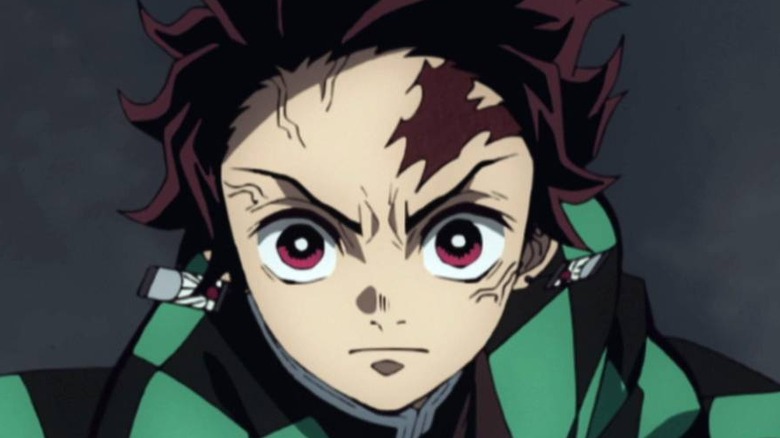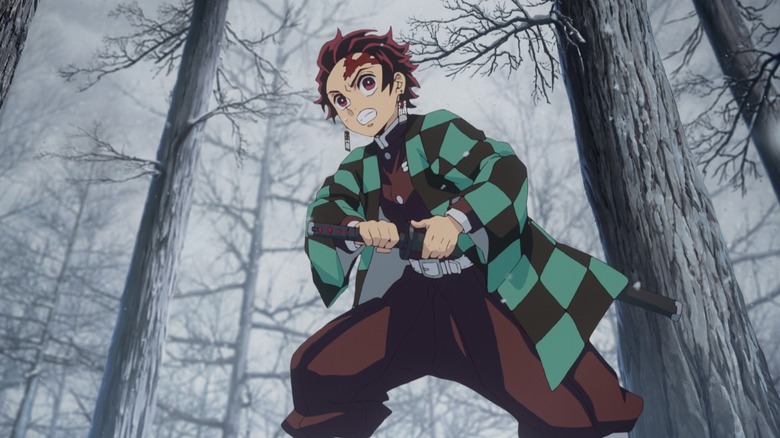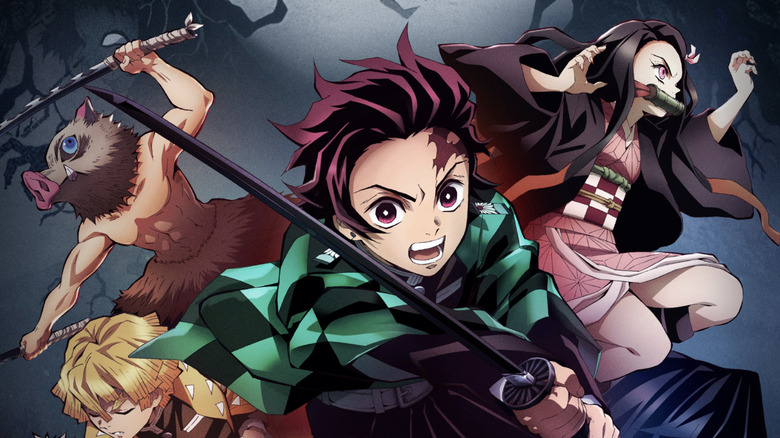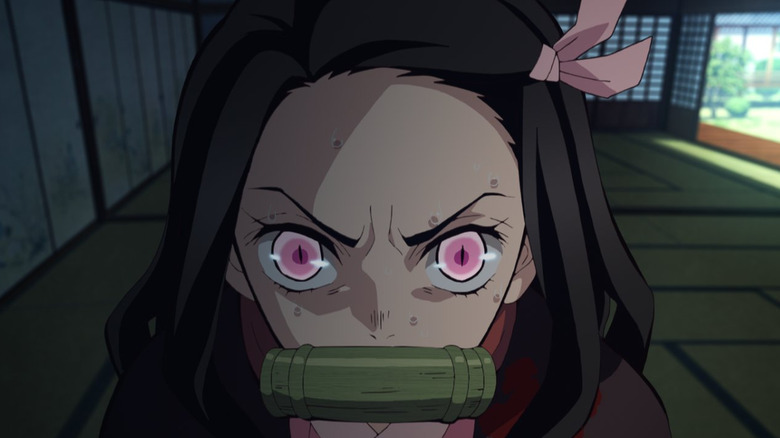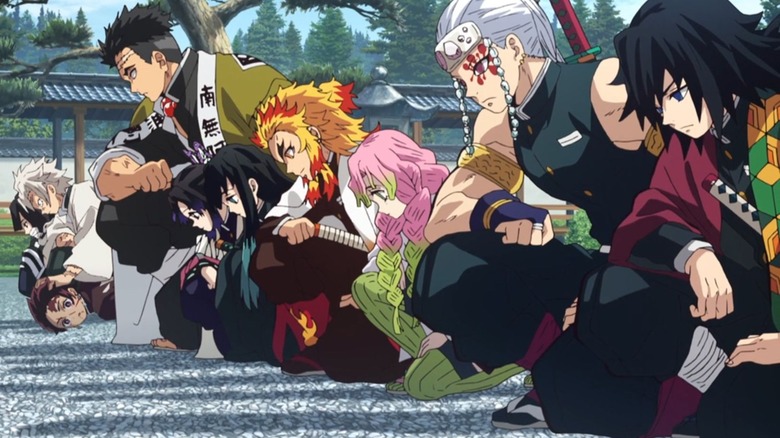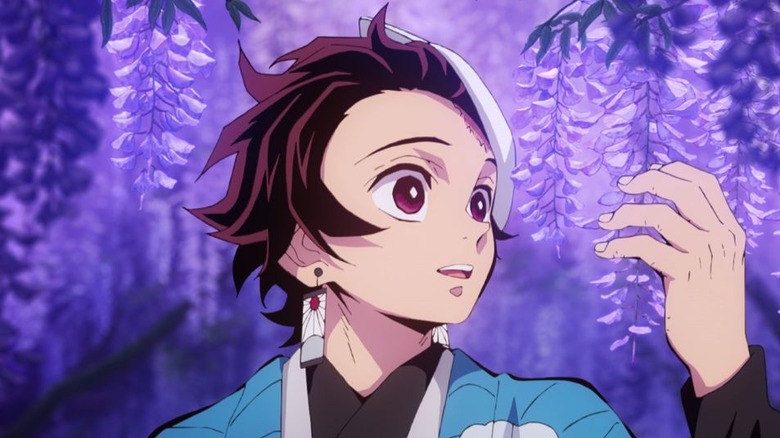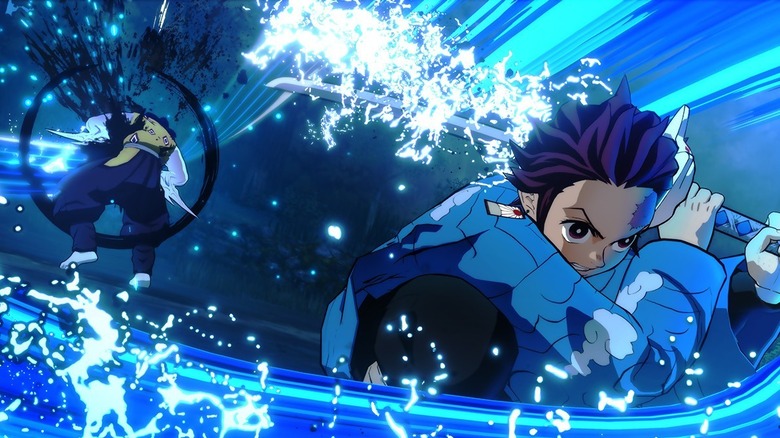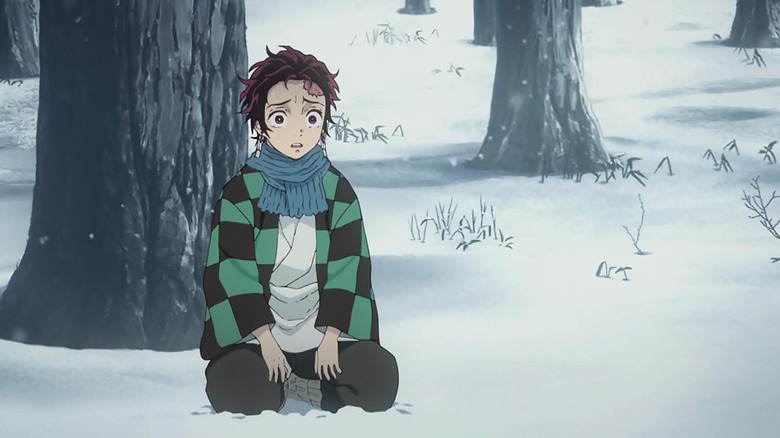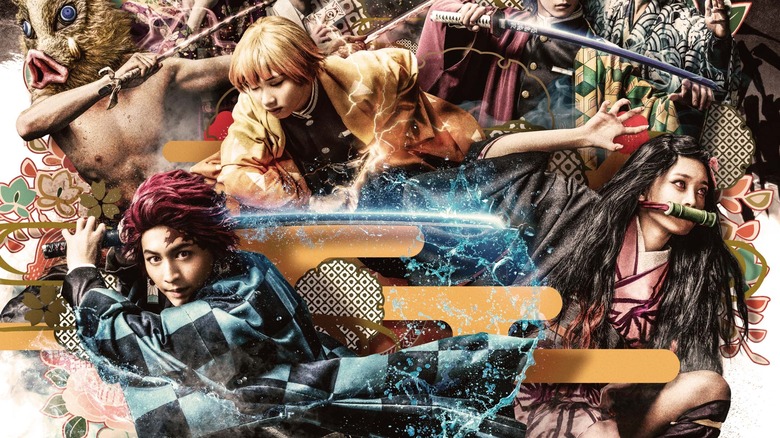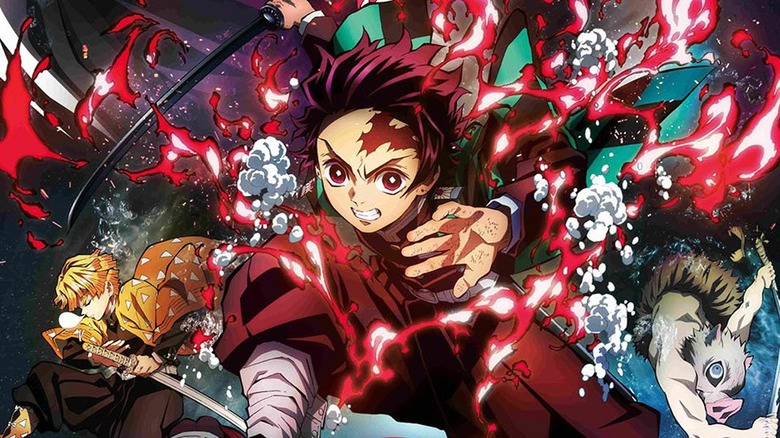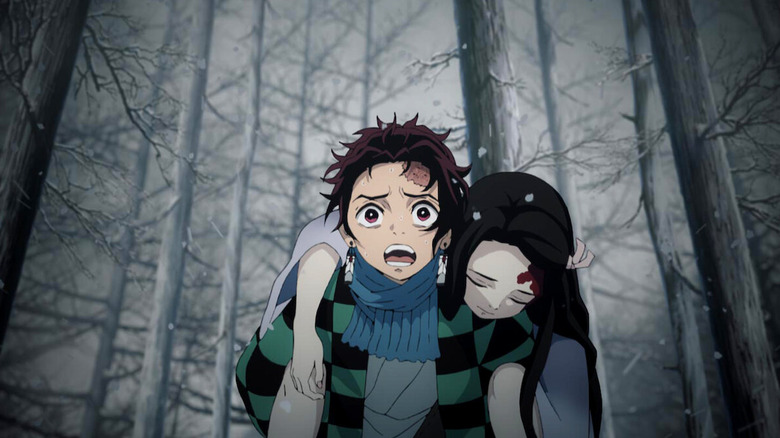The Untold Truth Of Demon Slayer
Seemingly overnight, "Demon Slayer: Kimetsu no Yaiba" has become an international sensation. The series began as a manga created by Koyoharu Gotouge, published in Weekly Shōnen Jump. An anime based on the manga began airing in Japan in 2019, and in short order, "Demon Slayer" began making itself known around the world. What started as a low rumbling of popularity quickly became an all-consuming tidal wave. Today, the "Demon Slayer" story has spread to nearly every medium. "Demon Slayer" on the page is one of the best-selling manga series of all time, with well over 150 million copies in print in both Japanese and English. "Demon Slayer" on the screen has become a pop culture sensation. And if that's not enough, "Demon Slayer" has also been made into video games, stage plays, and even an art exhibition.
The popularity of "Demon Slayer" is no coincidence. Koyoharu Gotouge spent years attempting to get a story serialized, and the manga's publishers worked hard to spread awareness of the series. The story of "Demon Slayer" is one of dedicated creative minds working overtime to give audiences a story and characters they can connect with. This is everything you never knew about the anime that has swept the world.
Demon Slayer's difficult beginning
Koyoharu Gotouge is the pen name of the anonymous author and illustrator behind "Demon Slayer". Gotouge has only published four other manga to date. Their debut one-shot, "Kagarigari", was awarded a Jump Treasure Newcomer Manga Award in 2013. Gotouge followed up "Kagarigari" with "Monju Shirō Kyōdai" in Jump Next!, and "Rokkotsu-san" in Weekly Shōnen Jump. After "Rokkotsu-san", Gotouge wanted to create a weekly series, and began working with editor Tatsuhiko Katayama on the manga "Haeniwa no Zigzag".
When "Haeniwa no Zigzag" wasn't picked up for serialization, the two knew they needed to change tactics. Thus, they used the themes of Gotogue's award-winning "Kagarigari" as the basis for their new story, "Demon Slayer: Kimetsu no Yaiba". This time they were met with success, and Weekly Shōnen Jump serialized the story.
Gotouge has gone to great lengths to maintain their anonymity, even as their popularity has skyrocketed. The author hasn't made public appearances, and the editors at Weekly Shōnen Jump do their best to protect Gotouge's identity. When Gotouge became the first manga creator to land on the Time 100 list in 2021, editor Kohei Ohnishi said the author's personality is present in the series via Tanjiro's "serious nature, honesty and strong sense of responsibility."
The key influence of Tatsuhiko Katayama
Tatsuhiko Katayama is the Weekly Shōnen Jump editor who helped Koyoharu Gotouge create "Demon Slayer". Katayama and Gotouge began working together shortly after the publication of "Rokkotsu-san". In an interview with Manga Plus, Katayama explained that the two of them decided focusing on a story with a simple Japanese motif would help them get to serialization. They decided to base their work on Gotouge's award-winning debut one-shot "Kagarigari".
Gotouge created a storyboard for a potential series titled "Kisatsu no Nagare". Katayama believed that it was too dark for serialization, however, and encouraged Gotouge to develop a "brighter, more normal character" to navigate the story's dismal world. The editor's instincts were right: Tanjiro Kamado, the protagonist of "Demon Slayer", is a major selling point of the series, largely because of his unwavering optimism in the face of constant violence and danger.
Katayama also explained his influence on the manga's title. Originally, Gotouge wanted to call the manga "Kisatsu no Yaiba". The character "satsu" means kill in Japanese, which Katayama felt was too intense to appeal to a wide swath of manga readers. So the duo brainstormed several potential replacements, and landed on "kimetsu." This isn't a real word in Japanese, but it borrows the character for "to perish," striking a lighter tone than "to kill." With those changes, "Demon Slayer: Kimetsu no Yaiba" was born.
Jumping to the English-speaking world
At 2017's Comic-Con International, Viz Media announced that they would be publishing "Demon Slayer" in English, via their Shōnen Jump imprint. The behemoth publisher had previewed the first three chapters of the manga in the digital edition of Shōnen Jump, and, apparently satisfied with fan response, committed to working their way through the rest of the series. When Viz Media began publishing "Demon Slayer" in English, the sixth volume of the manga had just been published in Japan by Shueisha, the company that owns Weekly Shōnen Jump.
Then, in January 2019, Shueisha launched a new platform called Manga Plus. While Viz Media has historically only published stories from Weekly Shōnen Jump on comparable platforms, Shueisha uses Manga Plus to publish their entire catalog in English. On top of that, Manga Plus aims to publish many of the company's titles simultaneously in Japanese and English. When the site launched, over 30 titles, including "Demon Slayer," were among its initial offerings. For the first time, English-speaking fans of the "Demon Slayer" manga were able to read new chapters at roughly the same time as their Japanese-speaking counterparts.
Licensing the Demon Slayer anime
It wasn't long after Viz Media published the English translations of "Demon Slayer" that the series made the leap to television. In 2018, Weekly Shōnen Jump announced that an anime adaptation of "Demon Slayer: Kimetsu no Yaiba" was being developed by Japanese animation studio Ufotable. Before working on "Demon Slayer," the studio was best known for its work on the "Fate/Night" series. Weekly Shōnen Jump also announced that the "Demon Slayer" anime would be directed by Haruo Sotozaki, who had previously overseen "Tales of Zestiria the X" and "Tales of Symphonia: The Animation". The show's 26 episodes aired in Japan from April 6 to September 28, 2019. Aniplex of America licensed the series for an English dub, which they released via Blu-ray in partnership with Funimation. The Blu-ray edition of "Demon Slayer" came out in the summer of 2020.
Now, many English-speaking anime fans had already been converted into "Demon Slayer" fanatics by that point. But the Blu-ray release was still an important opportunity to test the international market. Through this release, Aniplex and other involved parties got an even clearer image of their English-speaking audience — which, as it turned out, is gargantuan. It was starting to become clear that "Demon Slayer" wasn't just a success, but an international phenomenon.
Demon Slayer hits the big screen
Shortly after its release, the "Demon Slayer" movie became a worldwide, record-breaking phenomenon. However, the groundwork for the film's success had been laid out much earlier. The anime started airing in Japan in April 2019. Ahead of the anime's premiere, Ufotable prepared a limited theatrical run for the show. The first five episodes of the "Demon Slayer" anime were combined into a feature-length production entitled "Kimetsu no Yaiba: Kyodai no Kizuna," which translates to "Demon Slayer: The Bonds of Siblings." This feature was shown in 11 different theaters across Japan throughout late March and early April 2019. Ufotable, working to build as much hype for their new show as possible, ran television ads promoting the theatrical run.
When the anime crossed over to the English-speaking world, Aniplex of America decided to follow a similar, albeit more limited, strategy. The company announced on Twitter in November 2019 that a compilation of the show's first five episodes would be shown in New York City. Like their Japanese counterpart, Aniplex titled their theatrical compilation "Sibling's Bond". This feature was screened for a single day, but it served the same promotional purpose as the Japanese theatrical release. The success of both runs proved well in advance of the anime's success that "Demon Slayer" could potentially bring audiences out to the theater.
Popularity explosion
When the wave of "Demon Slayer" popularity hit, it hit hard. The first manga one-shot from "Demon Slayer" creator Koyoharu Gotouge was published in 2013. Three years later, Weekly Shōnen Jump picked up "Demon Slayer" for serialization. The series was published for two years before it was licensed as an anime. And then that anime changed everything.
Crunchyroll reported that over 4 million copies of the manga sold during the anime's run in Japan. In total, the manga sold over 10 million copies by September 2019. By February 2021, when "Demon Slayer" became available in English across most major streaming platforms, the manga had sold over 150 million copies, becoming one of the best selling manga series of all time.
Weekly Shōnen Jump editor-in-chief Hiroyuki Nakano agrees that the anime has much to do with the success of "Demon Slayer". In an interview with Nikkei Entertainment magazine, he said, "No matter how great a manga it is, it won't become a hit just because it ran in 'Jump.'" Nakano further theorized that the overabundance of manga outlets means that new series don't reach peak popularity as quickly as they did decades ago. The slow rise and sudden burst of "Demon Slayer" popularity certainly seems to back up the editor's theory: The anime gave it a crucial degree of buzz that put it over the top.
Riding the streaming wave
In December 2020, Funimation announced that they would be streaming the official English dub of "Demon Slayer." While they got the first opportunity to stream the hit series, other streaming platforms weren't far behind. By early 2021, "Demon Slayer" was also available on Crunchyroll, Hulu, and Netflix. With that wider availability came a much broader audience for the anime, and the popularity of "Demon Slayer" hit an all-time high.
The sudden availability of "Demon Slayer" on multiple streaming platforms spurred another spike in manga sales. In September 2020, the "Demon Slayer" manga had over 100 million copies in circulation. The manga was already among the highest-selling series published by Shueisha. By February 2021, shortly after the English dub of the anime came to major streaming platforms, the "Demon Slayer" manga had a stunning 150 million copies in circulation.
Streaming brought on a big spike, but the anime itself deserves most of the credit. When the anime first aired in Japan in 2019, the "Demon Slayer" manga had sold just 3.5 million copies. By the end of 2020, the economic impact of "Demon Slayer" was estimated at 270 billion yen in Japan. Such an incendiary rise to mainstream popularity is unheard of in almost any form of media, and "Demon Slayer" shows no sign of slowing down.
Demon Slayer on stage
No matter where they live, most die-hard "Demon Slayer" fans are able to avail themselves of the series in all its many forms. The manga is available in English through Viz Media and Manga Plus. The anime is available for streaming on Funimation, Crunchyroll, Netflix, and Hulu. The sequel film might just be in a theater near you, and it won't be long before fans can take it home with them.
There is one adaptation of the "Demon Slayer" story that remains exclusive to the series' Japanese fans, however. Weekly Shōnen Jump revealed in September 2019 that a stage adaptation of "Demon Slayer" would be coming to theaters. The stage play opened in Tokyo in mid-January 2020. Later that month, the production moved to Hyogo, where it finished its run in the first week of February.
While some fans may wonder how the fantastical story of "Demon Slayer" could possibly translate to the stage, the play was incredibly successful. In May 2021, a sequel play was announced, with most of the team from the original "Demon Slayer" play set to return. The sequel will have three different runs: Two in Tokyo, and a third in Osaka. The production will take place in the late summer of 2021.
Mugen Train shatters box office records
The first "Demon Slayer" anime series ends with a teaser for a sequel movie that sees the return of the show's entire cast and its director, Haruo Sotozaki. The film, which adapts the "Mugen Train" arc from the manga, was slated for release in Japan in October 2020 and in North America in April 2021. As "Demon Slayer" was just beginning to reach peak popularity at this point, expectations for the film were high. But few accurately predicted its level of success.
According to The Hollywood Reporter, "Demon Slayer the Movie: Mugen Train" became the highest-grossing film in Japanese history, with a staggering box office return of over $361 million. In the United States, the movie earned a box office debut of $21 million, making it the biggest domestic opening for a foreign-language film in the nation's history. By the end of its first 10 days in North America, the "Demon Slayer" movie had generated over $450 million globally.
"Demon Slayer" shattered the record previously set by Studio Ghibli's landmark film "Spirited Away," becoming the first Japanese movie to top $400 million at the box office. Early into its North American run, the film also became the most financially successful anime movie in history. "Demon Slayer" was gaining fans like never before, and anticipation for more had never been higher.
The dawn of the sequel series
With the massive success of the first "Demon Slayer" anime and its sequel film, a second series was all but guaranteed. Shueisha took their time announcing the series, however: The company waited until February 2021, when the "Demon Slayer" manga hit its sales peak, to unveil a teaser poster on Twitter. The sequel series is titled "Demon Slayer: Kimetsu no Yaiba — Yūkaku-hen". Like the "Mugen Train" film, this sequel series adapts a single arc from the manga, the "Entertainment District" storyline.
Ufotable will once again animate the massively popular series. Haruo Sotozaki is returning as diretor and showrunner, and the original cast will be reprising their roles from the initial series and sequel movie. Ufotable announced in a teaser trailer that the series will premiere in late 2021. They held back on revealing exactly how many episodes the series would contain, but the manga's "Entertainment District" storyline consists of 29 chapters, compared to the "Mugen Train" arc's 17. The film runs at just under two hours, roughly the length of six anime episodes. As a result, many fans assume that the second season of "Demon Slayer" will be shorter than the first — but probably no less entertaining.
